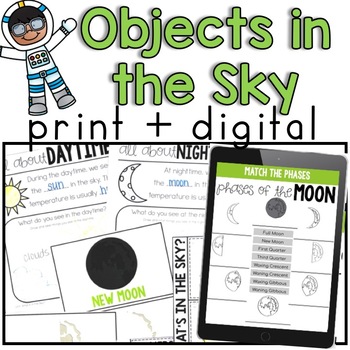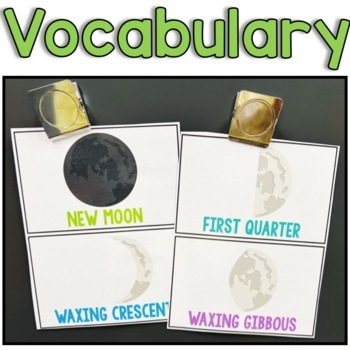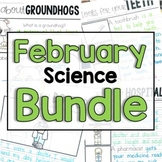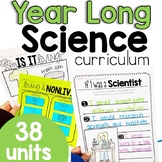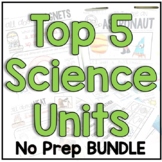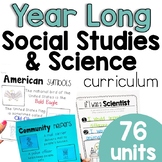Objects in the Sky: Sun, Moon and Stars (print + digital)
- PDF
What educators are saying
Also included in
- Connect science with your students’ every day lives using this bundle of everyday science topics that will have their minds buzzing with new questions! Students will explore what’s in the sky, groundhog facts and life cycles and facts about going to the doctor and the dentist!Each science unit willPrice $11.00Original Price $15.25Save $4.25
- Get a full year’s worth of Science units that are ready to click print and teach! This bundle of 38 Science units include physical science, matter and energy, animal research and more! Imagine this… You are able to plan out a year’s worth of science lesson plans with an easy year at a glance guide.Price $80.00Original Price $137.25Save $57.25
- I’ve bundled my top 5 science products sellers together! There’s no surprise to me that these 5 units are my best sellers. I love that I can teach them at any time of year. They also have SO many great writing opportunities and fun, engaging activities. #1 Objects in the SkyA low prep resource to tPrice $18.40Original Price $24.50Save $6.10
- Lifetime access to an entire year of my most loved resources: no prep Social Studies and Science activities! This bundle of 76 resources will give you one social studies and one science product for EVERY WEEK OF THE YEAR!76 Social Studies & Science Units that include ⭐️ Vocabulary⭐️ Printable WorkPrice $152.00Original Price $255.50Save $103.50
Description
Capture students’ interest with this all in one interactive unit about objects in the sky: sun, moon and stars! Enjoy one easy download of everything your students need to learn about what’s in the sky!
Students will learn features of daytime, features of nighttime, characteristics of the sun, moon, and stars as well as the moon's phases.
Here’s what you’ll get:
- 10 Picture/Vocabulary Cards
- 8 Phases of the Moon Cards
- 11 Printable Worksheets
- 5 Informational and Creative Writing Pages
- 5 Interactive Journals
- 19 pages of Digital Slides for Google Classroom
- Answer Keys
Students will love tracking the moon, writing about the sun/moon/stars, and the other activities that let them show all they had been learning about in regards to patterns in the sky!
These ready to “print and teach” activities will allow you to:
· Introduce new vocabulary with vocabulary cards
· Practice fine motor skills with cut and paste worksheets and interactive notebooks
· Compare information with graphic organizers
· Incorporate cross-curricular writing
❤️ SCIENCE MADE EASY-
Because most of these activities can be done independently, you can put them in your writing station or have students complete them for morning work.
❤️ PERFECT FOR SUBSTITUTES-
This product includes answer keys that make this the perfect activity to leave for a substitute!
❤️ TEACHERS LIKE YOU SAID….
⭐️⭐️⭐️⭐️⭐️Robin K. says, “I printed the pages at 80% and we used them in our science notebooks. I loved that it included different ways to show learning, like filling in the blanks and drawing a picture.”
⭐️⭐️⭐️⭐️⭐️Ashley C. says, “This resource opened up a plethora of different deep discussions with my class. They loved the week we went over space and this made it even better.”
✅WHAT’S INCLUDED:
10 Picture/Vocabulary Cards:
Star, Earth, Sun, Moon, Day, Night, Cloud, Planet, Sunrise, Sunset
8 Phases of the Moon Cards
11 Printable Worksheets
-Day and Night
-Sunrise and Sunset
-Light and Dark
-Comparing Temperatures
-All about Daytime
-All about Nighttime
-Observing the Moon
-Phases of the Moon
-KWL Chart: Sun
-KWL Chart: Moon
-KWL Chart: Stars
5 Informational and Creative Writing Pages
-Where does the sun go?
-I Know About Daytime
-I Know About Nighttime
-Patterns in the Stars
-If I Were an Astronaut
5 Interactive Journals
-Day and Night
-Sunrise and Sunset
-Sunrise, Daytime, Sunset, Nighttime
-Sun and Moon
-Planets
Answer Keys
19 pages of Digital Slides for Google Classroom
------------------------------------------------------------------------------------------------
For Texas Teachers, this resource relates to the following 2018 TEKS:
1.8B (K.8B, 2.8B) Observe and record changes in the appearance of objects in the sky such as clouds, the Moon, and stars, including the Sun.
1.8C (K.8C, 2.8C) Identify characteristics of the seasons of the year and day and night.
------------------------------------------------------------------------------------------------
You might also be interested in:
Objects in the Sky: Earth, Moon and Stars
Types of Energy: Light, Sound and Heat
Weather Types, Conditions and Tools
------------------------------------------------------------------------------------------------
Please leave feedback on how this product met your educational needs!
Also, follow me and be notified when new products are uploaded. New products are always 50% for the first 24 hours they are posted.
For more fun resources and freebies, visit my blog Kristen Sullins Teaching

